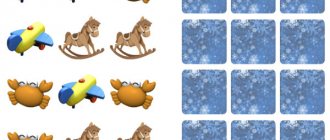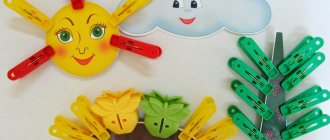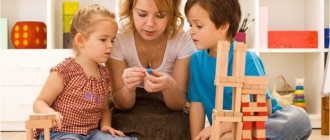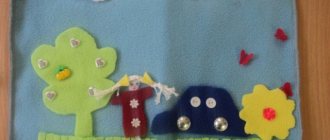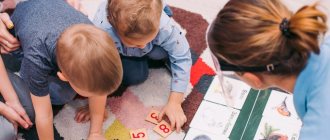The problem of developing the imagination of children of primary preschool age attracts the close attention of psychologists and teachers. Modern trends in the development of psychological science and educational practice raise new questions in its study. One of them is the question of individual characteristics of the development of imagination, manifestations of the child’s individuality in his creative activity. In the psychological literature there are different points of view on the origin and development of imagination.
Important!
The development of imagination is a consciously chosen process during which a person pursues the goal of improving his imagination, namely making it brighter, deeper and more special.
What is imagination? Creative imagination is the ability for the unexpected or intended appearance of any images, ideas, etc. in the mind and thoughts.
What arises in thoughts during an imagination may differ from reality. Imagination is a world separate from reality; thoughts, ideas and objects that do not exist in nature can appear in the imagination. It is imagination that helps in the mind to solve problems that require a visual representation.
Here's an example:
- how to insert a battery into a watch;
- how to insert a battery into a mouse;
- how to insert a battery into a calculator;
- how the lid of the pan is closed;
- how a nut is screwed onto a bolt.
These are all too simple and obvious examples. How about playing checkers or chess in your head, or assembling a clock mechanism from gears or a house from a construction set.
Important!
The first manifestations of imagination can be observed in children in the third year of life. By this time, the modern child has already accumulated some experience, and this provides material for the work of the imagination. A child, who has already learned to somewhat use a spoon, takes a match instead and “feeds” it to his grandmother or mother, and at the same time to the porcelain dog. This is how the imaginary “feeding” occurs.
Children of early three years of age already know how to listen to a simple fairy tale, experience it vividly, and sometimes add to it themselves. These first manifestations of imagination are still distinguished by significant poverty due to the child’s little experience and are, as it were, still tied to perceptions. The child only supplements with his imagination what he perceives.
Types of imagination
- Recreating. This includes images represented in thoughts according to the existing description: while reading poems, books, drawings, notes, etc. This type of imagination is otherwise called remembering, reproductive or reproducing.
- Creative. This is the formation of images or ideas independently at personal discretion.
- Uncontrollable. This type of imagination is known to most of us as absurdity and wild fantasy.
The benefits of a developed child's imagination
- the desire to learn new things, to look for answers to your questions;
- the ability to invent, fantasize, and compose on the fly. Lively, agile mindset, active in any activity;
- the ability to see banal things from an unusual angle;
- developed intuition, ability to guess;
- showing initiative;
- the ability to use experience - to apply skills and abilities previously acquired in other activities;
- solving problems in new ways.
These personality traits have one basis - the work of imagination and creative thinking. The more often a child fantasizes, the more he plays, engages in creative activities, the inclinations develop into abilities, creativity becomes a part of the child’s life in preschool age.
Development of children's spatial imagination
From an early age, a child is faced with the need to navigate in space. With the help of adults, he learns the simplest ideas about this: left, right, above, below, in the center, above, below, between, clockwise, counterclockwise, in the same direction, in the opposite direction, etc.
Attention!
All these concepts contribute to the development of spatial imagination in children. A child’s ability to imagine and predict what will happen in the near future in space lays the foundations for analysis and synthesis, logic and thinking.
Preschoolers are given the necessary primary information, and then the task is set: “What will happen if...”. The conditions under which the action must occur are formulated. The child must comprehend the data received, understand the task and make the right decision in the form of an oral or written answer.
Exercises to develop imagination for adults
A well-developed imagination is characterized primarily by a emancipation of consciousness, which cannot be achieved if one thinks in standard clichés. Is a rapana shell brought back from vacation good only to become an ashtray? Filled with soil mixture and secured with the hole facing up, the shell easily turns into a mini-pot for a dwarf cactus. Or, varnished, it forms the basis of a marine installation. How many other items in the house are “out of place”?
In addition to this simple mental training, which can be done anywhere, psychologists suggest using the following exercises to develop fantasy and imagination:
- "What if…". What if all the refrigeration systems in the world's supermarkets stopped working at the same time? What if the planet's air turns into laughing gas? By asking oneself such seemingly ridiculous questions and “expanding” them in detail to a comprehensive answer, a person learns to see ordinary things from an unexpected angle and find logical solutions in the most confusing situations.
- "Hidden meaning". This exercise in developing imagination from screenwriter Jean Peret can be played in your head every free minute when you have the opportunity to look through a magazine or image gallery on the Internet. You need to randomly open the first illustration you come across and try to come up with at least 10 humorous captions for it, revealing the secret meaning of the picture.
The now fashionable trend of dubbing foreign films with “goblin” translation is another great option to “upgrade” your idea of the normality of the world. When watching any film on TV, you just need to turn on the silent video mode and try to create your own version of the “voice acting” of the film. It may look stupid and even delusional, but with regular training, this exercise in developing imagination can transform an ordinary gray personality into a local humor star.
Methods for developing imagination in children
- Read more and while reading descriptions of nature, human appearance and the interior of a home, be sure to imagine all this in bright colors. When reading a fairy tale to your child, be sure to ask him to describe in his own words what this or that character or the area where the events take place looks like.
- Repeat in your head the day you actually lived vividly, in every detail, without missing out on any little detail: smells, sounds, light and color. In this case, you can mentally change events. Make it a rule to ask your child every evening about how his day went: which friends he met, what flower he saw in the flowerbed, etc.
- Start to paint the world or event in colors the way you would like to see it. Try, for example, asking your child to depict unusual animals or plants on an unknown planet, or to fantasize about what would happen if...
- You need to dream: bright, colorful and positive. Therefore, always support your child’s desire to dream. Under no circumstances should you tell your child phrases like “dreaming is harmful” or “dreams don’t come true.”
- It is unobtrusive to observe those around you and imagine what they think about, what they love, what they do in life. Invite your child to guess what, for example, a man in a uniform is doing or what a dog waiting for its owner near a store is thinking about.
- Start creating. Imagination is developed by the creation of creative things: knitting, weaving macrame, painting, writing fairy tales and poems, modeling from plasticine or clay, origami and other types of creativity. Provide your child with maximum opportunities to express his fantasies and realize his creative inclinations.
- Travel mentally: climb mountains, swim in the sea, fly into space, beyond the boundaries of our Universe. Fantasize with your child about, for example, a holiday together in some unusual place: visiting Santa Claus, on the island of Chunga-Changa, etc.
- Play multiplayer games in which each player has a specific role. Games can be either board games or role-playing games. The main thing is that adults take an active part and do not hesitate to express their positive feelings and emotions.
Age characteristics
Developing the ability to imagine is impossible without fantasy. These abilities are most clearly manifested in the child’s play and creative activities. They improve by going through two age stages.
- 2–4 years. The baby’s ideas are still involuntary; they arise spontaneously under the influence of a specific situation.
- 4–6 years. Ideas and fantasies become arbitrary. At this time, games turn into plots, surrounding objects become the material with which the child embodies the images of his imagination. At the same time, it not only performs a cognitive and intellectual function, but also regulates the mental state. In the game, a child can become a rescue hero, a conqueror of the seas, space, courageous, brave, and endow himself with qualities that he lacks in reality. This helps the development of intelligence, moral, emotional spheres, knowledge of the surrounding reality, the formation of personality, the development of self-awareness, thinking, volition, speech. Cognitive capabilities expand.
One of the unwanted “side effects” of developing imagination is the appearance of fears. The child may begin to be afraid of imaginary monsters, ghosts, invisible people, etc. If this happens, try to protect the child from situations that can provoke the appearance of such fears (watching horror stories, computer games with scary characters). And, of course, take measures to rid your child of fears. Don't be afraid to contact a child psychologist.
The child develops and acquires new skills during the game. And the basis of any playful and creative activity in preschoolers is precisely the ability to imagine.
The plots of games, invented stories, and drawings become richer over time. But at the age of 4 and 5 years, a preschooler cannot fantasize without performing some actions (he needs to tell, draw, design). Visual support for imagination fades into the background around the beginning of school age.
Take part in your child's story games. This will help you get to know him better. Indeed, in the process of such games, the baby transfers his traits, characteristics, fears, and dreams to the main character. You may discover hidden problems that require correction.
Games and exercises for developing imagination in preschoolers
Psychology notes the role of play in the formation of imagination as an extremely important means that gives a powerful impetus to the manifestation of fantasy (i.e., improvisation) in children. However, the choice of play methods will depend on the age of the child; depends on the individual characteristics of the imagination of each preschooler.
Important!
In preschool age, the leading types of activities are playful and creative. They are the ones who contribute to the education of all personal qualities of children, the full formation of their mental properties, and the disclosure of creative potential. In home education, play and creativity are the most accessible ways to develop imagination in preschoolers.
Exercise “What our palms look like”
Goal: development of imagination and attention.
Invite children to trace their own palm (or two) with paints or pencils and come up with, fantasize, “What could this be?” (tree, birds, butterfly, etc.). Offer to create a drawing based on the circled palms.
Game - exercise “Three colors”.
Goal: development of artistic perception and imagination.
Execution technology: invite children to take three colors that, in their opinion, are most suitable for each other, and fill the entire sheet with them in any way. What does the drawing look like?
Exercise "Magic Blots".
Goal: development of creative imagination; learn to find similarities between images of unclear outlines and real images and objects.
Suggest that you drop any paint onto the middle of the sheet and fold the sheet in half. The result was various blots; children need to see in their blot what it looks like or who it resembles.
Exercise "Magic thread".
Goal: development of creative imagination; learn to find similarities between images of unclear outlines and real images and objects.
In the presence of children, dip a thread 30-40 cm long in ink and place it on a sheet of paper, curling it randomly. Place another sheet on top of the thread and press it to the bottom one. Pull out the thread while holding the sheets. A trace of the thread will remain on the paper; children are asked to identify and name the resulting image.
Game – “Unfinished Drawing”.
Goal: development of creative imagination.
Children are given sheets with images of unfinished objects. You are invited to complete the drawing of the object and talk about your drawing.
Exercise "Wizards".
Goal: development of emotionality and creative imagination.
Methodology: without a preliminary conversation, invite children to use pencils to transform two completely identical figures depicted on a sheet into an evil and a good wizard. Next, ask them to figure out what bad the “evil” wizard did and how the “good” one defeated him.
Exercise "Dance".
Goal: development of emotionality and creative imagination.
Invite children to come up with their own image and dance it to certain music. The rest of the children must guess what image is intended.
Options - the image is given, all children dance at the same time (“blooming flower”, “affectionate cat”, “snowfall”, “cheerful monkey”, etc.).
Complication – to convey feelings in dance (“joy”, “fear”, “surprise”, etc.)
Exercise “What the music told you about.”
Goal: development of creative imagination.
Classical music is playing. Children are asked to close their eyes and imagine what the music is saying, and then draw their ideas and talk about them.
Game "What is this?"
Goal: to teach children to create new images in their imagination based on the perception of substitute objects.
Circles of different colors and strips of different lengths are used. Children stand in a circle. The teacher shows one of the colored circles, puts it in the center and asks them to tell what it looks like. Answers should not repeat each other.
Game "Pebbles on the Shore".
Goal: to learn to create new images based on the perception of schematic images.
A large painting depicting a seashore is used. 7-10 pebbles of different shapes are drawn. Everyone should have a resemblance to some object, animal, person.
The teacher says: “A wizard walked along this shore and turned everything that was in his way into pebbles. You have to guess what was on the shore, say about each pebble, who or what it looks like.” It is desirable that several pebbles have almost the same contour. Next, invite the children to come up with a story about their pebble: how did it end up on the shore? What happened to him? Etc.
Exercise "Magic Mosaic".
Goal: to teach children to create objects in their imagination, based on a schematic representation of the details of these objects.
Sets of geometric shapes cut out of thick cardboard (the same for each child) are used: several circles, squares, triangles, rectangles of different sizes.
The teacher hands out the kits and says that this is a magical mosaic from which you can put together a lot of interesting things. To do this, you need to attach different figures, as you wish, to each other so that you get some kind of image. Offer a competition: who can put together the most different objects from their mosaic and come up with some kind of story about one or more objects.
Game "Let's help the artist."
Purpose of the lesson: to teach children to imagine objects based on the scheme given to them.
Material: a large sheet of paper attached to a board with a diagram of a person drawn on it. Colored pencils or paints.
The teacher says that one artist did not have time to finish the picture and asked the children to help him finish the picture. Together with the teacher, the children discuss what and what color is best to draw. The most interesting proposals are embodied in the picture. Gradually, the diagram is completed, turning into a drawing.
Then invite the children to come up with a story about the drawn person.
Game "Magic Pictures".
Goal: to teach to imagine objects and situations based on schematic images of individual parts of objects.
The children are given cards. Each card contains a schematic representation of some object details and geometric shapes. Each image is located on the card so that there is free space for finishing the picture. Children use colored pencils.
Children can turn each figure depicted on the card into the picture they want. To do this, you need to draw whatever you want to the figure. After finishing painting, children write stories based on their paintings.
Game "Wonderful transformations".
Goal: to teach children to create objects and situations in their imagination based on visual models.
The teacher gives the children pictures with images of substitute objects, each with three stripes of different lengths and three circles of different colors. Children are invited to look at the pictures, come up with what they mean, and draw the corresponding picture (several are possible) on their sheet of paper with colored pencils. The teacher analyzes the completed drawings together with the children: notes their correspondence to the depicted substitute objects (in shape, color, size, quantity, originality of content and composition.
Game "Wonderful Forest".
Goal: to teach how to create situations in your imagination based on their schematic representation.
Children are given identical sheets of paper, several trees are drawn on them, and unfinished, unformed images are located in different places. The teacher suggests drawing a forest full of miracles with colored pencils and telling a fairy tale about it. Unfinished images can be turned into real or imaginary objects.
For the assignment, you can use material on other topics: “Wonderful Sea”, “Wonderful Glade”, “Wonderful Park” and others.
Game "Changes".
Goal: to learn to create images of objects in the imagination based on the perception of schematic images of individual parts of these objects.
Children are given sets of 4 identical cards, with abstract schematic images on the cards. Assignment for children: each card can be turned into any picture. Stick the card on a piece of paper and use colored pencils to draw whatever you want to create a picture. Then take another card, stick it on the next sheet, draw again, but on the other side of the card, that is, turn the figure into another picture. You can turn the card and sheet of paper over as you want while drawing! Thus, you can turn a card with the same figure into different pictures. The game lasts until all the children finish drawing the figures. Then the children talk about their drawings.
Game "Different Tales".
Goal: to teach children to imagine various situations using a visual model as a plan.
The teacher builds any sequence of images on the demonstration board (two standing men, two running men, three trees, a house, a bear, a fox, a princess, etc.) Children are asked to come up with a fairy tale based on the pictures, observing their sequence.
You can use various options: the child independently composes the entire fairy tale; the next child should not repeat its plot. If this is difficult for children, you can compose a fairy tale for everyone at the same time: the first one starts, the next one continues. Next, the images are swapped and a new fairy tale is composed.
Exercise “Come up with your own ending to the fairy tale.”
Goal: development of creative imagination.
Invite children to change and create their own ending to familiar fairy tales.
“The bun did not sit on the fox’s tongue, but rolled further and met...”
“The wolf didn’t manage to eat the kids because...”, etc.
The game “Good-Bad” or “Chain of Contradictions”.
Goal: development of creative imagination by searching for contradictions.
The teacher begins - “A” is good, because “B”. The child continues - “B” is bad because “B”. The next one says - “B” is good because “G”, etc.
Example: walking is good because the sun is shining. The sun is shining - it’s bad because it’s hot. Hot is good because it’s summer, etc.
Game "Fairy-tale animal (plant)".
Goal: development of creative imagination.
Invite children to come up with and draw a fantastic animal or plant that is not like the real thing. After drawing a picture, each child talks about what he drew and comes up with a name for what he drew. Other children look for features of real animals (plants) in his drawing.
Exercise "Fairy tale - story."
Goal: development of creative imagination, the ability to distinguish reality from fantasy.
After reading a fairy tale, children, with the help of a teacher, separate in it what can really happen from what is fantastic. It turns out two stories. One is completely fantastic, the other is completely real.
An infinite number of similar games and exercises can be created; it all depends only on the creative imagination skills of adults who have set themselves the goal of helping every child grow up to be a creatively gifted, unconventionally thinking, successful person.
Useful drawing
In the process of drawing, children perfectly develop their ability to imagine. You can come up with many non-standard designs.
- From simple to complex. Kids are offered the simplest drawn figures (a circle, a figure eight, a square, two parallel lines), which need to be completed into something more concrete (a figure eight can become glasses, a circle can become the sun or a car wheel).
- Blots. A preschooler is given an image of some kind of blot. His job is to say what it looks like by going through many options. Another option is to draw the blot into a recognizable image.
- Pictures from dots. A sheet is placed in front of the baby, on which dots are placed in a chaotic order. His task is to connect them to obtain a specific image.
- Mood. Similar to “thematic” dances, you can arrange a “drawing” game. The child depicts his mood at the moment, or his mood as instructed by an adult (draw fear, joy, anger, fun).
All these games will help kids develop their creative skills and imagination. You can come up with others, using the imagination of adults. The main thing is to motivate the child to come up with something. As you age, these games can become even more difficult. When starting school, it is useful to connect them with the knowledge acquired in the lessons, motivating the child to learn and create new products of the imagination. Well, there is no need to repeat why this is useful.
Development of children's creative imagination in drawing
Drawing is probably the most famous and widely used form of creative activity. Thanks to drawing, a child develops memory, learns to concentrate, improves fine motor skills, analyzes everything, compares, looks for differences, drawing makes the child think and think.
At a very young age, a child pays more attention to the qualities that this or that material has; the drawings of five-year-old children can already be understood and comprehended; at the age of 10, a child is already making plot-based drawings.
Important! Drawing helps to establish and strengthen the connection between the right and left hemispheres of a child’s brain, which is why it has such a strong influence on the baby’s development.
Drawing materials today are very diverse, from crayons to all kinds of paints.
We paint with paints (finger paints, watercolors, gouache)
In Europe, painting with children aged 6 months and older has been practiced for more than 20 years and has positive results.
It is the colors that give more scope for imagination.
- Firstly, they are more convenient to draw; when working with them, you do not need to make an effort, as when drawing with pencils or felt-tip pens.
- Secondly, they can be mixed and get new colors and shades.
- Thirdly, you can use different tools for drawing, the child can choose the method he likes most.
Finger paint
Finger paints are great for little ones because they are made from safe materials, and even if the child licks his finger in the paint, moms have nothing to worry about. In addition, such paints are easy to wash and wash off clothes. This is quite a nice bonus, because the baby will not limit himself to drawing only on paper.
Gouache
Gouache is suitable for slightly older children, from about two years old, because... it is not as safe as finger paints and is harder to wash. Gouache can also be painted with fingers, palms, or with a brush. Let the child first paint with it, as well as with his usual finger paints, and then show him how to do it with a brush.
Important! Children under 3 years old cannot hold a brush correctly and control the intensity of pressure, so don’t demand too much from your baby, let him master it.
Children really like gouache because... has the following properties:
- it is opaque;
- dissolves well in water;
- you can draw with it on canvas, on a sheet of paper, and even on wood;
- dries well and after drying becomes matte and velvety;
- odorless, therefore suitable for children;
- it is very dense, with rich color.
Drawing with gouache
From the age of two, a child can be given coloring books, just choose large drawings with a minimum of details to begin with. Show your child how to color without going overboard. Try different colors.
Important! Gouache is very good because you can mix colors and get new ones. The young researcher should enjoy this activity.
Watercolor paints
From the age of four, a child’s drawings already acquire more recognizable outlines and he can already be given watercolors.
Watercolor is a water-soluble paint, so it washes off easily with water. Paintings painted in watercolor create the impression of weightlessness, translucency and lightness.
The smaller the child, the fewer colors you choose to work with. For a schoolchild, 12 colors are enough, for younger children even less. The colors of watercolor paints can be mixed on a separate palette to create new colors and shades.
Important!
Also, to work with watercolors you will need brushes; it is better to choose soft and high-quality ones, for example, made from pony or squirrel hair.
Explain to your child that before taking a new color, the brush must be washed well in water, otherwise the colors will mix.
There is special paper for watercolors; it differs from regular paper in that the drawings on it are brighter and, accordingly, more vibrant. In addition, it will not wrinkle from moisture.
We develop from an early age
So, the ability to imagine and fantasize develops most actively in children from 4 to 10 years old. But this does not mean that until then it is not worth improving these skills. From about 2 years old, you can begin to teach your child the ability to imagine. This will be a good foundation for improving it in the future.
How to encourage your baby to imagine?
- It is useful to play “make-believe” with him. This can be done in any situation. For example, walking on the street. You can show your baby the clouds and ask what they look like (to begin with, the mother can offer her own version). At this age, very simple images will appear, familiar to the baby (horse, house, bird, flower). You can ask about anything. Let's say, what are the sparrows chirping about: are they discussing delicious grains or a scary cat? What are the leaves on the tree whispering about: about the warm sun, about the evil wind, about harmful insects? Where does the cat run: after the mouse, to its children, to the owner for a treat? In this way, a small child will develop thinking, speech, and observation skills.
- At home and on the street, you can look for similarities between objects and toys familiar to the baby (what looks like a ball, a cube, a brick, a pyramid?).
- Construction using small parts (cubes, Legos) is very useful. You can add various boxes to your arsenal of “building materials”.
Books for developing children's imagination (for parents)
| Book title | book author |
| Preschool psychology. | Uruntaeva G.A. |
| Developing imagination in children: a popular guide for parents and teachers. | Subbotina L.Yu. |
| Development of creative imagination in children. | Solovey L.B. |
| Study of imagination and creativity of preschool children in foreign psychology // Preschool education. | Sinelnikov V. |
| Down the rabbit hole: metamorphosis and nonsense in children's imagination // Questions of psychology. | Sapogova E.E. |
| Psychology of a preschooler. Reader. | G.A. Uruntaeva. |
| Fantasy playgrounds // Preschool education. | Preusler O. |
| Fantasy and reality. | Petrovsky A.V. and etc. |
| Development of imagination in children of the second year of life // Preschool education. | Palagina N. |
| Psychology of a preschooler. | Mukhina V.S. |
| Preschool child: a new approach to diagnosing creative abilities // Preschool education. | Kudryavtsev V., Sinelnikov V. |
| Development of imagination // Preschool education. | Kravtsova E. |
| Imagination and its role in cognition. | Korshunova L.S. |
| Games and exercises for the development of mental abilities in preschool children: Book. for a kindergarten teacher garden | L.A. Wenger, O.M. Dyachenko. |
How to develop imagination as an adult
Plunging headlong into the routine of everyday worries, an adult consciously limits his vision of the world to the narrow framework of the events and images he needs. This does not mean that his ability to imagine is lost, but it becomes more and more difficult for him to realize it every year.
Exercises for developing imagination in adults are created taking into account the need to abandon the baggage of old patterns that force one to think in stereotypes. The consciousness of an adult is designed in such a way that when trying to think outside the box, a whole chain of defense mechanisms is activated in his head. For this reason, from the first days you should not try to devote more than 10 minutes at a time to exercises to develop your imagination.
It is advisable to start with simple observation in conditions close to everyday ones - for example, on the way home from work. Even a path traveled many times can be fraught with many surprises that will both amuse and shock you if you look at them more closely. An amusingly composed advertisement on the wall, the burning windows of a high-rise building forming alphabetic or numerical signs - once you open your mind to the unusual, your imagination will work with redoubled force.
